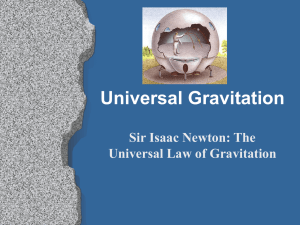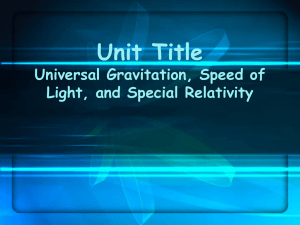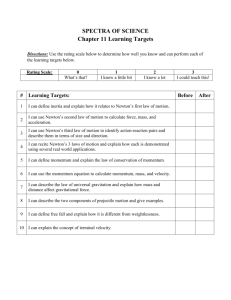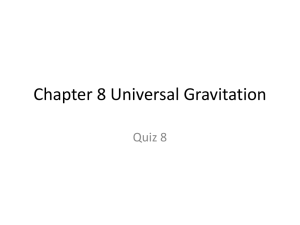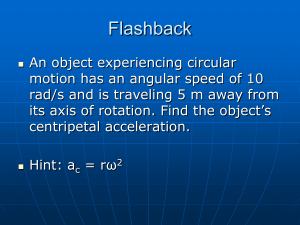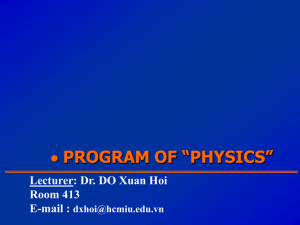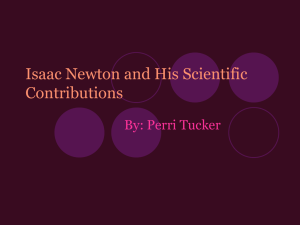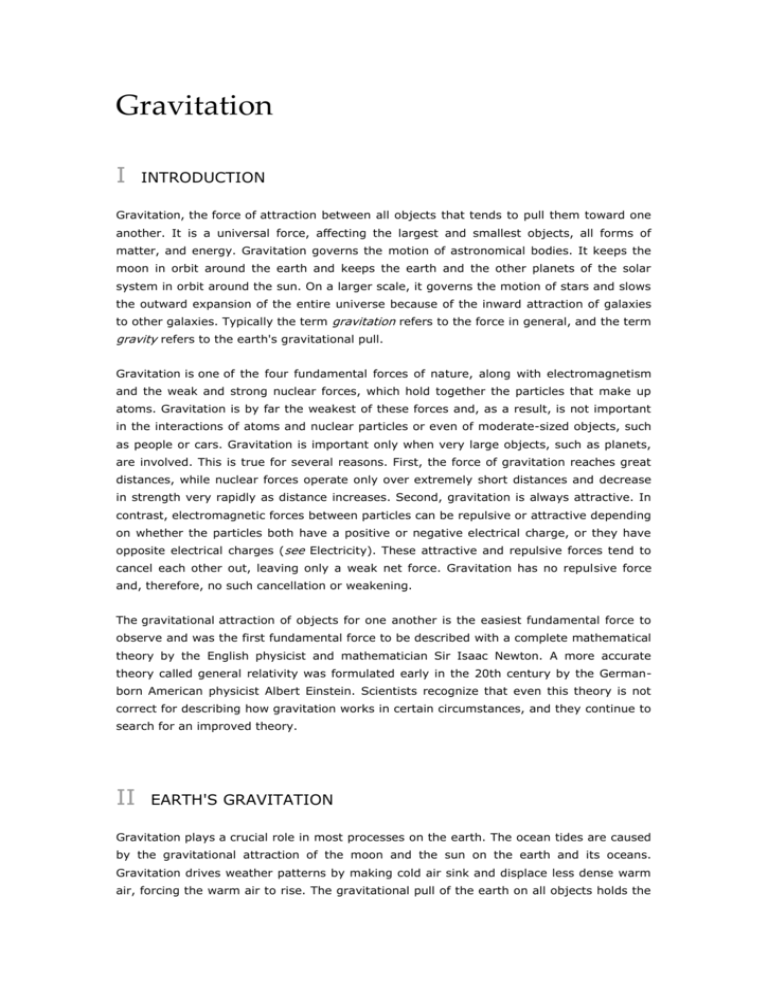
Gravitation
I
INTRODUCTION
Gravitation, the force of attraction between all objects that tends to pull them toward one
another. It is a universal force, affecting the largest and smallest objects, all forms of
matter, and energy. Gravitation governs the motion of astronomical bodies. It keeps the
moon in orbit around the earth and keeps the earth and the other planets of the solar
system in orbit around the sun. On a larger scale, it governs the motion of stars and slows
the outward expansion of the entire universe because of the inward attraction of galaxies
to other galaxies. Typically the term gravitation refers to the force in general, and the term
gravity refers to the earth's gravitational pull.
Gravitation is one of the four fundamental forces of nature, along with electromagnetism
and the weak and strong nuclear forces, which hold together the particles that make up
atoms. Gravitation is by far the weakest of these forces and, as a result, is not important
in the interactions of atoms and nuclear particles or even of moderate-sized objects, such
as people or cars. Gravitation is important only when very large objects, such as planets,
are involved. This is true for several reasons. First, the force of gravitation reaches great
distances, while nuclear forces operate only over extremely short distances and decrease
in strength very rapidly as distance increases. Second, gravitation is always attractive. In
contrast, electromagnetic forces between particles can be repulsive or attractive depending
on whether the particles both have a positive or negative electrical charge, or they have
opposite electrical charges (see Electricity). These attractive and repulsive forces tend to
cancel each other out, leaving only a weak net force. Gravitation has no repulsive force
and, therefore, no such cancellation or weakening.
The gravitational attraction of objects for one another is the easiest fundamental force to
observe and was the first fundamental force to be described with a complete mathematical
theory by the English physicist and mathematician Sir Isaac Newton. A more accurate
theory called general relativity was formulated early in the 20th century by the Germanborn American physicist Albert Einstein. Scientists recognize that even this theory is not
correct for describing how gravitation works in certain circumstances, and they continue to
search for an improved theory.
II
EARTH'S GRAVITATION
Gravitation plays a crucial role in most processes on the earth. The ocean tides are caused
by the gravitational attraction of the moon and the sun on the earth and its oceans.
Gravitation drives weather patterns by making cold air sink and displace less dense warm
air, forcing the warm air to rise. The gravitational pull of the earth on all objects holds the
objects to the surface of the earth. Without it, the spin of the earth would send them
floating off into space.
The gravitational attraction of every bit of matter in the earth for every other bit of matter
amounts to an inward pull that holds the earth together against the pressure forces
tending to push it outward. Similarly, the inward pull of gravitation holds stars together.
When a star's fuel nears depletion, the processes producing the outward pressure weaken
and the inward pull of gravitation eventually compresses the star to a very compact size
(see Star, Black Hole).
A
Acceleration
If an object held near the surface of the earth is released, it will fall and accelerate, or pick
up speed, as it descends. This acceleration is caused by gravity, the force of attraction
between the object and the earth. The force of gravity on an object is also called the
object's weight. This force depends on the object's mass, or the amount of matter in the
object. The weight of an object is equal to the mass of the object multiplied by the
acceleration due to gravity.
A bowling ball that weighs 16 lb is actually being pulled toward the earth with a force of 16
lb. In the metric system, the bowling ball is pulled toward the earth with a force of 71
newtons (a metric unit of force abbreviated N). The bowling ball also pulls on the earth
with a force of 16 lb (71 N), but the earth is so massive that it does not move appreciably.
In order to hold the bowling ball up and keep it from falling, a person must exert an
upward force of 16 lb (71 N) on the ball. This upward force acts to oppose the 16 lb (71 N)
downward weight force, leaving a total force of zero. The total force on an object
determines the object's acceleration.
If the pull of gravity is the only force acting on an object, then all objects, regardless of
their weight, size, or shape, will accelerate in the same manner. At the same place on the
earth, the 16 lb (71 N) bowling ball and a 500 lb (2200 N) boulder will fall with the same
rate of acceleration. As each second passes, each object will increase its downward speed
by about 9.8 m/sec (32 ft/sec), resulting in an acceleration of 9.8 m/sec/sec (32
ft/sec/sec). In principle, a rock and a feather both would fall with this acceleration if there
were no other forces acting. In practice, however, air friction exerts a greater upward force
on the falling feather than on the rock and makes the feather fall more slowly than the
rock.
The mass of an object does not change as it is moved from place to place, but the
acceleration due to gravity, and therefore the object's weight, will change because the
strength of the earth's gravitational pull is not the same everywhere. The earth's pull and
the acceleration due to gravity decrease as an object moves farther away from the center
of the earth. At an altitude of 4000 miles (6400 km) above the earth's surface, for
instance, the bowling ball that weighed 16 lb (71 N) at the surface would weigh only about
4 lb (18 N). Because of the reduced weight force, the rate of acceleration of the bowling
ball at that altitude would be only one quarter of the acceleration rate at the surface of the
earth. The pull of gravity on an object also changes slightly with latitude. Because the
earth is not perfectly spherical, but bulges at the equator, the pull of gravity is about 0.5
percent stronger at the earth's poles than at the equator.
III
EARLY IDEAS ABOUT GRAVITATION
The ancient Greek philosophers developed several theories about the force that caused
objects to fall toward the earth. In the 4th century
, the Greek philosopher Aristotle
BC
proposed that all things were made from some combination of the four elements, earth,
air, fire, and water. Objects that were similar in nature attracted one another, and as a
result, objects with more earth in them were attracted to the earth. Fire, by contrast, was
dissimilar and therefore tended to rise from the earth. Aristotle also developed a
cosmology, that is, a theory describing the universe, that was geocentric, or earthcentered, with the moon, sun, planets, and stars moving around the earth on spheres. The
Greek philosophers, however, did not propose a connection between the force behind
planetary motion and the force that made objects fall toward the earth.
At the beginning of the 17th century, the
Italian physicist and astronomer Galileo
discovered that all objects fall toward the earth with the same acceleration, regardless of
their weight, size, or shape, when gravity is the only force acting on them. Galileo also had
a theory about the universe, which he based on the ideas of the Polish astronomer
Nicolaus Copernicus. In the mid-16th century, Copernicus had proposed a heliocentric, or
sun-centered system, in which the planets moved in circles around the sun, and Galileo
agreed with this cosmology. However, Galileo believed that the planets moved in circles
because this motion was the natural path of a body with no forces acting on it. Like the
Greek philosophers, he saw no connection between the force behind planetary motion and
gravitation on earth.
In the late 16th and early 17th centuries the heliocentric model of the universe gained
support from observations by the Danish astronomer Tycho Brahe, and his student, the
German astronomer Johannes Kepler. These observations, made without telescopes, were
accurate enough to determine that the planets did not move in circles, as Copernicus had
suggested. Kepler calculated that the orbits had to be ellipses (slightly elongated circles).
The invention of the telescope made even more precise observations possible, and Galileo
was one of the first to use a telescope to study astronomy. In 1609 Galileo observed that
moons orbited the planet Jupiter, a fact that could not reasonably fit into an earthcentered model of the heavens.
The new heliocentric theory changed scientists' views about the earth's place in the
universe and opened the way for new ideas about the forces behind planetary motion.
However, it was not until the late 17th century that Isaac Newton developed a theory of
gravitation that encompassed both the attraction of objects on the earth and planetary
motion.
IV
NEWTON'S THEORY OF GRAVITATION
To develop his theory of gravitation, Newton first had to develop the science of forces and
motion called mechanics. Newton proposed that the natural motion of an object is motion
at a constant speed on a straight line, and that it takes a force to slow down, speed up, or
change the path of an object. Newton also invented calculus, a new branch of mathematics
that became an important tool in the calculations of his theory of gravitation.
Newton proposed his law of gravitation in 1687 and stated that every particle in the
universe attracts every other particle in the universe with a force that depends on the
product of the two particles' masses divided by the square of the distance between them.
The gravitational force between two objects can be expressed by the following equation:
F= GMm/d2 where F is the gravitational force, G is a constant known as the universal
constant of gravitation, M and m are the masses of each object, and d is the distance
between them. Newton considered a particle to be an object with a mass that was
concentrated in a small point. If the mass of one or both particles increases, then the
attraction between the two particles increases. For instance, if the mass of one particle is
doubled, the force of attraction between the two particles is doubled. If the distance
between the particles increases, then the attraction decreases as the square of the
distance between them. Doubling the distance between two particles, for instance, will
make the force of attraction one quarter as great as it was.
According to Newton, the force acts along a line between the two particles. In the case of
two spheres, it acts along the line between their centers. The attraction between objects
with irregular shapes is more complicated. Every bit of matter in the irregular object
attracts every bit of matter in the other object. A simpler description is possible near the
surface of the earth where the pull of gravity is approximately uniform in strength and
direction. In this case there is a point in an object (even an irregular object) called the
center of gravity, at which all the force of gravity can be considered to be acting.
Newton's law affects all objects in the universe, from raindrops in the sky to the planets in
the solar system. It is therefore known as the universal law of gravitation. In order to
know the strength of gravitational forces in general, however, it became necessary to find
the value of G, the universal constant of gravitation. Scientists needed to perform an
experiment, but gravitational forces are very weak between objects found in a common
laboratory and thus hard to observe. In 1798 the English chemist and physicist Henry
Cavendish finally measured G with a very sensitive experiment in which he nearly
eliminated the effects of friction and other forces. The value he found was 6.754 x 10 -11 Nm2/kg2—close to the currently accepted value of 6.670 x 10 -11 N-m2/kg2 (a decimal point
followed by 10 zeros and then the number 6670). This value is so small that the force of
gravitation between two objects with a mass of 1 metric ton each, 1 meter from each
other, is about 67 millionths of a newton, or about 15 millionths of a pound.
Gravitation may also be described in a completely different way. A massive object, such as
the earth, may be thought of as producing a condition in space around it called a
gravitational field. This field causes objects in space to experience a force. The
gravitational field around the earth, for instance, produces a downward force on objects
near the earth surface. The field viewpoint is an alternative to the viewpoint that objects
can affect each other across distance. This way of thinking about interactions has proved
to be very important in the development of modern physics.
A
Planetary Motion
Newton's law of gravitation was the first theory to accurately describe the motion of
objects on the earth as well as the planetary motion that astronomers had long observed.
According to Newton's theory, the gravitational attraction between the planets and the sun
holds the planets in elliptical orbits around the sun. The earth's moon and moons of other
planets are held in orbit by the attraction between the moons and the planets. Newton's
law led to many new discoveries, the most important of which was the discovery of the
planet Neptune. Scientists had noted unexplainable variations in the motion of the planet
Uranus for many years. Using Newton's law of gravitation, the French astronomer Urbain
Leverrier and the British astronomer John Couch each independently predicted the
existence of a more distant planet that was perturbing the orbit of Uranus. Neptune was
discovered in 1864, in an orbit close to its predicted position.
B
Problems with Newton's Theory
Scientists used Newton's theory of gravitation successfully for many years. Several
problems began to arise, however, involving motion that did not follow the law of
gravitation or Newtonian mechanics. One problem was the observed and unexplainable
deviations in the orbit of Mercury (which could not be caused by the gravitational pull of
another orbiting body).
Another problem with Newton's theory involved reference frames, that is, the conditions
under which an observer measures the motion of an object. According to Newtonian
mechanics, two observers making measurements of the speed of an object will measure
different speeds if the observers are moving relative to each other. A person on the ground
observing a ball that is on a train passing by will measure the speed of the ball as the
same as the speed of the train. A person on the train observing the ball, however, will
measure the ball's speed as zero. According to the traditional ideas about space and time,
then, there could not be a constant, fundamental speed in the physical world because all
speed is relative. However, near the end of the 19th century the Scottish physicist James
Clerk Maxwell proposed a complete theory of electric and magnetic forces that contained
just such a constant, which he called c. This constant speed was 300,000 km/sec (186,000
mi/sec) and was the speed of electromagnetic waves, including light waves. This feature of
Maxwell's theory caused a crisis in physics because it indicated that speed was not always
relative.
Albert Einstein resolved this crisis in 1905 with his special theory of relativity. An important
feature of Einstein's new theory was that no particle, and even no information, could travel
faster than the fundamental speed c. In Newton's gravitation theory, however, information
about gravitation moved at infinite speed. If a star exploded into two parts, for example,
the change in gravitational pull would be felt immediately by a planet in a distant orbit
around the exploded star. According to Einstein's theory, such forces were not possible.
Though Newton's theory contained several flaws, it is still very practical for use in
everyday life. Even today, it is sufficiently accurate for dealing with earth-based
gravitational effects such as in geology (the study of the formation of the earth and the
processes acting on it), and for most scientific work in astronomy. Only when examining
exotic phenomena such as black holes (points in space with a gravitational force so strong
that not even light can escape them) or in explaining the big bang (the origin of the
universe) is Newton's theory inaccurate or inapplicable.
V
EINSTEIN'S THEORY OF RELATIVITY
In 1915 Einstein formulated a new theory of gravitation that reconciled the force of
gravitation with the requirements of his theory of special relativity. He proposed that
gravitational effects move at the speed of c. He called this theory general relativity to
distinguish it from special relativity, which only holds when there is no force of gravitation.
General relativity produces predictions very close to those of Newton's theory in most
familiar situations, such as the moon orbiting the earth. Einstein's theory differed from
Newton's theory, however, in that it described gravitation as a curvature of space and
time.
In Einstein's general theory of relativity, he proposed that space and time may be united
into a single, four-dimensional geometry consisting of 3 space dimensions and 1 time
dimension. In this geometry, called spacetime, the motions of particles from point to point
as time progresses are represented by curves called world lines. If there is no gravity
acting, the most natural lines in this geometry are straight lines, and they represent
particles that are moving always in the same direction with the same speed—that is,
particles that have no force acting on them. If a particle is acted on by a force, then its
world line will not be straight. Einstein also proposed that the effect of gravitation should
not be represented as the deviation of a world line from straightness, as it would be for an
electrical force. If gravitation is present, it should not be considered a force. Rather,
gravitation changes the most natural world lines and thereby curves the geometry of
spacetime. In a curved geometry, such as the two-dimensional surface of the earth, there
are no straight lines. Instead, there are special curves called geodesics, an example of
which are great circles around the earth. These special curves are at each point as straight
as possible, and they are the most natural lines in a curved geometry. The effect of
gravitation would be to influence the geodesics in spacetime. Near sources of gravitation
the space is strongly curved and the geodesics behave less and less like those in flat,
uncurved spacetime. In the solar system, for example, the effect of the sun and the earth
is to cause the moon to move on a geodesic that winds around the geodesic of the earth
12 times a year.
A
Testing Einstein's Theory
Einstein's theory required verification, but the level of precision in measurement needed to
distinguish between Einstein's theory and Newton's theory was difficult to achieve in the
early 20th century and remains so today. There were two predictions, however, that could
be tested. One involved deviations in the orbit of Mercury. Astronomers had observed that
the ellipse of Mercury's orbit itself rotated—that is, the point nearest the sun, called the
perihelion, slowly advanced around the sun. The rate of advancement predicted by
Newton's theory differed slightly from what astronomers had measured, but Einstein's
theory predicted the correct rate.
The second test involved measuring the bending of light as it passed around the sun. Both
Newton's and Einstein's theories predicted that light would be deflected by gravitation. But
the amount of deflection predicted by the two theories differed. The light to be measured
in such a test originates in distant stars. However, under ordinary conditions the sun's
brightness prevents scientists from observing the light from these stars. This problem
disappears during an eclipse, when the moon blocks the sun's light. In 1919 a special
British expedition took photographs during an eclipse. Scientists measured the deflection
of starlight as it passed by the sun and arrived at numbers that agreed with Einstein's
prediction. Subsequent eclipse observations also have confirmed Einstein's theory.
Other physicists have proposed relativistic theories of gravitation to compete with
Einstein's. In these competing theories, almost all of which are geometrical like Einstein's,
gravitational effects move at the speed c. They differ mostly in the mathematical details.
Even using the technology of the late 20th century, scientists still find it very difficult to
test these theories with experiments and observations. But Einstein's theory has passed all
tests that have been made so far.
B
Applications of Einstein's Theory
Einstein's general relativity theory predicts special gravitational conditions. The Big Bang
theory, which describes the origin and early expansion of the universe, is one conclusion
based on Einstein's theory that has been verified in several independent ways.
Another conclusion suggested by general relativity, as well as other relativistic theories of
gravitation, is that gravitational effects move in waves. Astronomers have observed a loss
of energy in a pair of neutron stars (stars composed of densely packed neutrons) that are
orbiting each other. The astronomers theorize that energy-carrying gravitational waves are
radiating from the pair, depleting the stars of their energy. Very violent astrophysical
events, such as the explosion of stars or the collision of neutron stars, can produce
gravitational waves strong enough that they may eventually be directly detectable with
extremely precise instruments. Astrophysicists are designing such instruments with the
hope that they will be able to detect gravitational waves by the beginning of the 21st
century.
Another gravitational effect predicted by general relativity is the existence of black holes.
The idea of a star with a gravitational force so strong that light cannot escape from its
surface can be traced to Newtonian theory. Einstein modified this idea in his general
theory of relativity. Because light cannot escape from a black hole, for any object—a
particle, spacecraft, or wave—to escape, it would have to move past light. But light moves
outward at the speed c. According to relativity, c is the highest attainable speed, so
nothing can pass it. The black holes that Einstein envisioned, then, allow no escape
whatsoever. An extension of this argument shows that when gravitation is this strong,
nothing can even stay in the same place, but must move inward. Even the surface of a
star must move inward, and must continue the collapse that created the strong
gravitational force. What remains then is not a star, but a region of space from which
emerges a tremendous gravitational force.
VI
OTHER MODERN THEORIES
Einstein's theory of gravitation revolutionized 20th-century physics. Another important
revolution that took place was quantum theory. Quantum theory states that physical
interactions, or the exchange of energy, cannot be made arbitrarily small. There is a
minimal interaction that comes in a packet called the quantum of an interaction. For
electromagnetism the quantum is called the photon. Like the other interactions, gravitation
also must be quantized. Physicists call a quantum of gravitational energy a graviton. In
principle, gravitational waves arriving at the earth would consist of gravitons. In practice,
gravitational waves would consist of apparently continuous streams of gravitons, and
individual gravitons could not be detected.
Einstein's theory did not include quantum effects. For most of the 20th century, theoretical
physicists have been unsuccessful in their attempts to formulate a theory that resembles
Einstein's theory but also includes gravitons. Despite the lack of a complete quantum
theory, it is possible to make some partial predictions about quantized gravitation. In the
1970s, British physicist Stephen Hawking showed that quantum mechanical processes in
the strong gravitational pull just outside of black holes would create particles and quanta
that move away from the black hole, thereby robbing it of energy.
A
Theory of Everything
An important trend in modern theoretical physics is to find a theory of everything (TOE), in
which all four of the fundamental forces are seen to be really different aspects of the same
single universal force. Physicists already have unified electromagnetism and the weak
nuclear force and have made progress in joining these two forces with the strong nuclear
force (see Grand Unification Theories). However, relativistic gravitation, with its geometric
and mathematically complex character, poses the most difficult challenge. Einstein spent
most of his later years searching for an all-encompassing theory by trying to make
electromagnetism geometrical like gravitation. The modern approach is to try to make
gravitation fit the pattern of the other fundamental forces. Much of this work involves
looking for mathematical patterns. A TOE is difficult to test using experiments because the
effects of a TOE would be important only in the rarest circumstances.
Contributed
By:
Richard H. Price
Microsoft ® Encarta ® Reference Library 2003. © 1993-2002 Microsoft Corporation. All
rights reserved.


